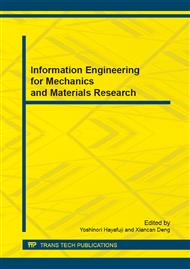[1]
Y. Sakamura and H. Komaki, Numerical simulation of the propagation of stress disturbance in shock-loaded granular media using the discrete element method, Shock Waves, Springer Berlin Heidelberg, (2009).
DOI: 10.1007/978-3-540-85181-3_5
Google Scholar
[2]
D. J. Benson, The calculation of the shock velocity - particle velocity relationship for a copper powder by direct numerical simulation, Wave. Motion. 21 (1995) 85-99.
DOI: 10.1016/0165-2125(94)00044-6
Google Scholar
[3]
T. J. V. John P. Borg, Mesoscale calculations of the dynamic behavior of a granular ceramic, Int.J. Solids. Struct. 45 (2008) 1676-1696.
DOI: 10.1016/j.ijsolstr.2007.10.027
Google Scholar
[4]
L. L. Jiangtao Zhang, Pengcheng Zhai, Zheng Yifu, Qingjie Zhang, The prediction of the dynamic responses of ceramic particle reinforced MMCs by using multi-particle computational micro-mechanical method, Compos. Sci. Technol. 67 (2007) 2775-2785.
DOI: 10.1016/j.compscitech.2007.02.002
Google Scholar
[5]
K.A. Brown, R.B. a.O. A, Meso-scale modelling of shock wave propagation in a cellular glass particle reinforced thermoplastic composite, The 18th International Conference on Composite Materials, Jeju Island, South Korea (2011).
Google Scholar
[6]
Ryan A Austin, Numerical simulation of shock wave propagation in spatially-resolved particle systems, Model. Simu. Mater. Sc. 14 (2006) 537-561.
DOI: 10.1088/0965-0393/14/4/001
Google Scholar
[7]
R. Aaboe, Foamed glass-an alternative lightweight and insulating material, Nordic Road Transport Research. 17 (2005).
Google Scholar
[8]
H. B. A. Borbe´ly , O. Hartmann, FE investigation of the effect of particle distribution on the uniaxial stress–strain behaviour of particulate reinforced metal-matrix composites, Mat. Sci. Eng. A-Struct. 313 (2001) 34-45.
DOI: 10.1016/s0921-5093(01)01144-3
Google Scholar
[9]
M. R. Baer, Modeling heterogeneous energetic materials at the mesoscale, Thermochim. Acta. 384 (2002) 351-367.
DOI: 10.1016/s0040-6031(01)00794-8
Google Scholar
[10]
W. P. Zhenbi Su, Zhaoyan Zhang, Numerical simulation of a novel blast wave mitigation device, Int. J. Impact. Eng. 35 (2008) 336-346.
Google Scholar
[11]
Y. S. Phua, The measurement of shock propagation in composite materials, Department of Mechanical, Materials and Manufacturing University of nottingham, (2012).
Google Scholar


